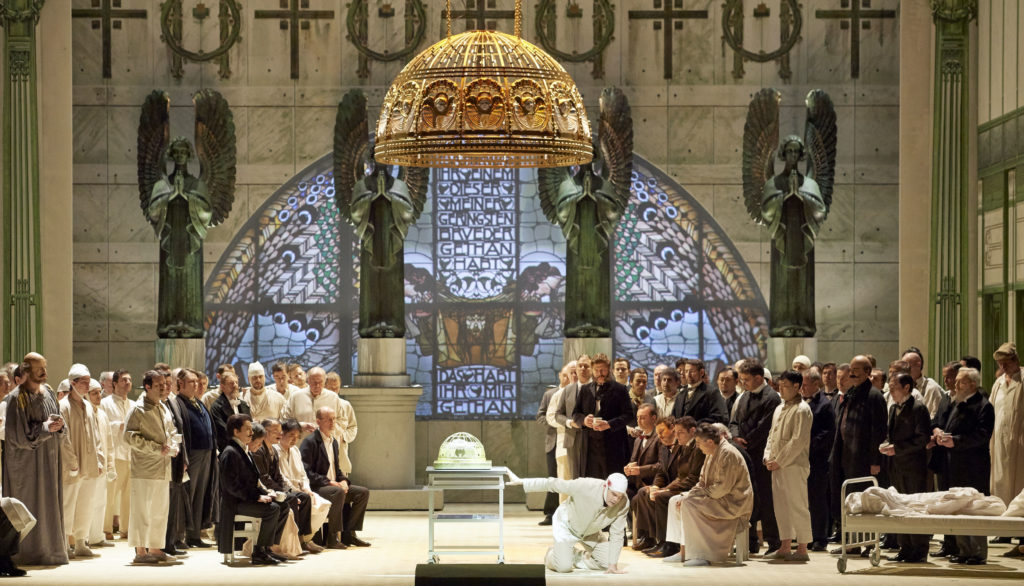 In Vienna State Opera’s new production, director Alvis Hermanis sets Wagner’s Parsifal in pre-World War Vienna; the stage design cites the Viennese architecture of Otto Wagner, his hospital complex in Steinhof and the Wagner Church. For Hermanis, the search for the Grail is also a pursuit of spiritual enlightenment; and Gurmaniz and Klingsor are two doctors, in a polarisation of good and evil, fighting for control of their patients’ soul.
In Vienna State Opera’s new production, director Alvis Hermanis sets Wagner’s Parsifal in pre-World War Vienna; the stage design cites the Viennese architecture of Otto Wagner, his hospital complex in Steinhof and the Wagner Church. For Hermanis, the search for the Grail is also a pursuit of spiritual enlightenment; and Gurmaniz and Klingsor are two doctors, in a polarisation of good and evil, fighting for control of their patients’ soul.
It opens in a hospital ward with rows of white beds; on the lower stage, ‘the Doctor’ Gurmenanz (René Pape) at his desk, behind him a glass bookcase. The Wagner Spital , a progressive psychiatric institution outside Vienna, was spectacularly beautiful in the jugendstil (art nouveau), as recreated in Hermanis’s set. The backdrop is an arched stained-glass window of the chapel; and elaborate jugendstil motifs embellish the walls.
In the introduction, the awakening patients in white cross themselves before four statues of saints, while ornate screens slide across the stage separating the ‘wards’. This is the backdrop to Richard Wagner’s sublime Prelude: what we hear is profoundly moving, Vienna State Opera Orchestra (Chorus and extra Choruses) conducted by inspirational Semyon Bychkov.
Nina Stemme’s Kundry, the archetypal transgressive woman in Wagner’s scheme – she wanders restlessly from age to age, once ‘laughed at Jesus on the cross’- is dragged in like a mad woman, attended by nurses with syringes . Amfortas, (the King of the Grail wounded by the holy spear Klingsor stole), is wheeled in on a bed brought front of stage. He looks grey and dying. But his voice, Gerald Finley’s rich baritone, is very much alive.
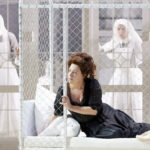 Kundry is kept in a cage (representing an isolation ward?), under the doctor’s observation. She alone is dressed in black against the predominant white of other patients in night gowns (as if sitting in group therapy.) We see her having a fit in her cage: is this a new diva thing?
Kundry is kept in a cage (representing an isolation ward?), under the doctor’s observation. She alone is dressed in black against the predominant white of other patients in night gowns (as if sitting in group therapy.) We see her having a fit in her cage: is this a new diva thing?
In the plot Parsifal appears in the Grail’s domain, a sacred area where only the chosen are allowed. Gurmenanz, a comrade of Titorel, the first King of the Grail (Jongmin Park’s resonant bass), leads ‘the young Parsifal’ to Amfortas’s castle . Christopher Ventris, an always competent but unexceptional tenor, appears as the archetypal 19th century romantic hero in a rustic forest green outfit , but with a gold waistcoat (or is it brass armour?) Parsifal’s entrance is preceded by the discovery of a dead swan, connecting with Wagner’s Lohengrin narrative (where Lohengrin finds the Holy Grail.) Pepe’s Gurmenanz dominates the first Act, and has the longest solo as he takes Ventris’ Parsifal under his wings, believing he has found the proverbial ‘Pure Fool.’
The set is a white marble effect, with Hapsburg imperial-green panelling . Very effective are the decorative panels which slide open, as a multitude enter for the Order’s religious ceremony: including a bearded, balding character uncannily reminiscent of Gustav Klimt. A glow envelopes the stage as the Grail’s golden dome, suspended, is lowered. Intricately embossed, it is both suggestive of religious sacraments, also quintessentially ‘jugendstil’ (modelled on the Altar dome of the Otto Wagner church.)
Parsifal looks on as Amfortas (Finley) pleads to be relieved of his duty uncovering the Grail. But obliged to submit, Amfortas is led on, supported on each side. Verdammt zu sein , Finley’s wonderful baritone is both powerful and plaintive, Park’s (Titurel) incredible bass reverberates.
Backstage the warm gold light illuminates the stained glass windows (of the chapel at the rear) , depicting the Order’s coat of arms, elaborately-feathered bird of prey. The nurses distribute bread to the inmates; later sacrificial wine. The concept seems so right, be it a 19th century hospital, workhouse, asylum: and here a ‘Christian’ order, the bread and wine as sacraments. They drink as bells ring against Wagner’s orchestration. The sliding doors close off the stage as Parsifal , seemingly impervious to Amfortas’s suffering, exasperates Gurmenanz his mentor with his silence, as he disappears off stage.
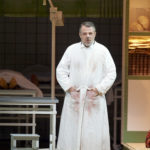 It all started so well. But Act 2 goes too far; it opens in an operating theatre, table centre-stage, where Kundry is receiving electric shock therapy (not in 1900, surely?) and wakes up screaming . Die Zeit ist da (now is the time), sings magnificent tenor Jochen Schmeckenbecher as Klingsor.
It all started so well. But Act 2 goes too far; it opens in an operating theatre, table centre-stage, where Kundry is receiving electric shock therapy (not in 1900, surely?) and wakes up screaming . Die Zeit ist da (now is the time), sings magnificent tenor Jochen Schmeckenbecher as Klingsor.
Nina Stemme is on a luxurious red-Persian patterned couch, with presumably her psychoanalyst hovering over her. Schmeckenbecher, facing her on the opposite stage, handles a giant model of a brain. She wanders through beds of sheet-covered corpses, presumably his experiments: pretty nasty connotations, anticipating Nazi (Mengeles’) brain research on disabled and psychiatric patients.‘Eine Wunde trägt jede nach Heim, cites a caption projected back of stage. Klingsor’s white surgeon’s coat is blood-stained!
Parsifal has somehow entered Klingsor’s domain- the ward. The stage is invaded by countless look-alikes (the flower girls), all with long, white gowns, their hair, like Stemme’s, an auburn red. Wagner’s ‘sirens’ are enchanting, beguiling. Sensational effect, as they freeze in their movements.
Stemme’s Kundry, in a shimmering gold dress, her long trestles trailing, wearing a gold broach, earrings the size of headphones. A jugendstil goddess out of a Klimt painting. An oasis of beauty against the horrid, clinical, white-walled operating theatre. She’s resplendent on that oriental couch. And, really, Stemme’s soprano oozes sensuousness. She’s holding a white bundle, as if representing the child Parsifal she’d brought up instead of his mother.
Now it’s Ventris reclining, then perched on a hospital trolley. Gold spangles in her hair, gold art nouveau earrings, who could resist this Eve’s temptations? 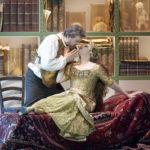 She cups his head, and kisses him passionately, he laid out on the trolley. He jumps up startled, as if bitten by a snake. Wunder.. The gold dome of the Grail has been lowered. Ventris stretches out his arms as if to embrace it. Stemme is again lounging on her couch. The dome withdraws upwards.
She cups his head, and kisses him passionately, he laid out on the trolley. He jumps up startled, as if bitten by a snake. Wunder.. The gold dome of the Grail has been lowered. Ventris stretches out his arms as if to embrace it. Stemme is again lounging on her couch. The dome withdraws upwards.
More captions of the plot (from Wagner’s original score?) are projected back-screen. An iconic Jesus figure (juxtaposed against the script), a reproduction of Non me tangere– Jesus holding off Mary Magdalene- comments on Parsifal’s rejection of the seductress Kundry.
Stemme, with her long brown curls, looking like some she-wolf predator, takes Ventris’s head in her arms. He holds up his hands to stop up his ears. She’s now standing, as if to fly off her trolley- commanding her magic powers, Stemme, her hands raised like a queen of the night. Ventris holds the magic spear, like a golden sword, and exits through a side door.
In Act III, Im Gebiet des Grales, we revert to the Wagner Hospital , the patients in their ward behind one of the jugendstil screens. But to spoil it there’s that grotesque brain – now even bigger- as if it’s going to take over like in a horror movie. Front of stage Stemme’s Kundry is in bed, under bedclothes. Still there, Gurmenanz shouts at Kundry. Get up! He thought she was dead. She is one apart from the others. Oh, day of mercy, Heil, du mein Gast, sings Pape movingly.
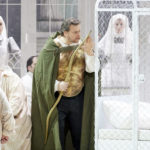 On walks a warrior figure, in gold armour, carrying a golden spear and shield, and antique helmet, reminiscent of knights of old. Seated on her bed, Kundry now calm, beckons to him. (Inmates stare through the partition.) Do you still recognise me, He, verändert durch alles , underwent a transition to find the path to holiness. Oh, Mercy! Pape holds up the sacred spear. Stemme sits by Ventriss’s side. She pulls off his leggings, and leads him centre stage where he sits enthroned. She washes his feet (another Magdalene reference.)
On walks a warrior figure, in gold armour, carrying a golden spear and shield, and antique helmet, reminiscent of knights of old. Seated on her bed, Kundry now calm, beckons to him. (Inmates stare through the partition.) Do you still recognise me, He, verändert durch alles , underwent a transition to find the path to holiness. Oh, Mercy! Pape holds up the sacred spear. Stemme sits by Ventriss’s side. She pulls off his leggings, and leads him centre stage where he sits enthroned. She washes his feet (another Magdalene reference.)
Wagner’s sublime Good Friday Music. Mein erstes Akt verricht ich so, sings Pape. Patients are sitting still, observing in wonderment. Bells ring. They gather round the brain of white matter pushed centre-stage. The panels withdraw, revealing the arch backstage, (reminiscent of the Otto Wagner Pavilion), inscribed beneath, Die Zeit. In walk the Knights of the Holy Grail radiant in gold; the Grail’s dome descends. Amfortas rises from his bed, in such pain. Oh welches Wunder, welches Glück, wonderfully sung by Finley. Stemme’s Kundry tends the Holy Grail like a priestess. The suspended Grail is now placed onto the giant brain. Strange, rather grotesque. So it’s a ‘humanist’ ending glorifying the human mind and science.
But Hermanis has taken an inspired idea, using the Wagner Hospital, to crass extremes; yet the jugendstil-inspired sets have a timeless appeal, as with the Pre-Raphaelites, revering the medieval, the very mythology behind Parsifal. Musically, with Bychkov conducting Vienna forces, and a cast headed by Finlay, Pape, and Stemme, there can be no quibbles.© P.R. 30.3.2013
Photos: Nina Stemme as Kundry; Jochen Schmeckenbecher, Klingsor ; Christopher Ventris as Parsifal and Nina Stemme, Kundry; Christopher Ventris, Parsifal
© Wiener Staatsoper/ Michael Pöhn
viennaoperareview.com
Vienna's English opera blog
